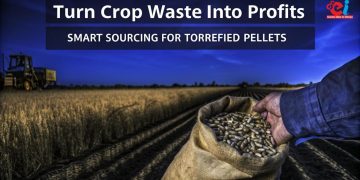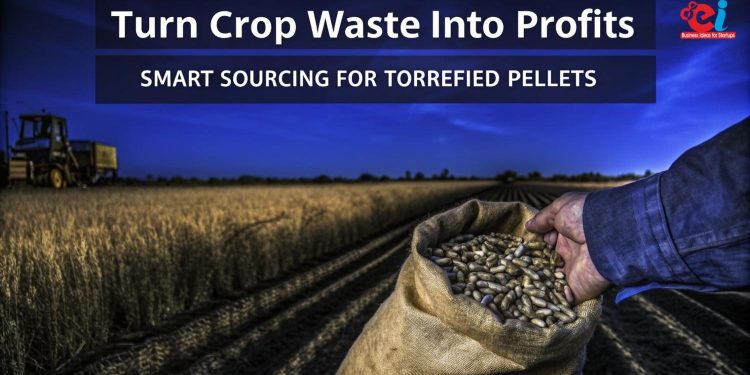As a potential clean energy alternative, torrefied biomass pellets are gaining popularity as high-grade biofuels in comparison to wood pellets and raw biomass. These pellets are now gaining interest from thermal power plants, cement kilns, and industrial boilers because of their high calorific value, strong self-sustaining combustion properties, lower emissions, and resin-like flammability.
But even the best strategy around the operations wouldn’t work if there isn’t agro-waste ready to be processed—this indicates that all torrefied pellets plant start around the supply chain and need to focus on sourcing agro-waste first. Feedstock availability, dependability, quality, and logistics impact productivity, profitability, and environmental impact directly. A poorly designed strategy for raw material sourcing can cause a setback in operations, increasing costs, or worst case scenario, outgrowing the project budget.
This paper aims to address how one can develop a strong and scalable supply chain around agricultural waste tailored specifically for torrefied pellet plants retaining all essential sustainability and quality benchmarks across the entire supply chain.
The Role of Agro-Waste in Refined Torrefied Biomass Pellets
The torrefaction process entails the thermal treatment of biomass with moderate heating (200 – 320°C) under a limited oxygen environment. This transforms the biomass into solid, energy-rich, hydrophobic material similar to coal while significantly diminishing the emission of sulfur, nitrogen, and particulate materials. Since moisture and volatile substances are removed, the energy concentration in the final torrefied pellets is significantly higher.
Agricultural by-products are extremely readily accessible in economies such as India, making them ideal filler materials for torrefied pellets. Agricultural residues like paddy straw, wheat husk, sugarcane bagasse, cotton stalks, mustard husk, maize cobs, and groundnut and coconut husks are often allowed to decompose or openly burned, contributing grossly to environmental pollution. The use of this biomass can greatly reduce emissions and waste burning while creating a rural sustainable economical framework.
Agro-waste biomass does pose some hurdles, the most critical being seasonality. Other issues include bulkiness of raw material, high moisture content, and variability in calorific value. Therefore, it is imperative for a torrefied pellet producer to establish a sustainable strategy for sourcing raw material that guarantees year-round supply, consistent quality, and low-cost procurement.
Related: Profitable Biomass Pellet Business: Non-Torrefied & Torrefied Pellets
Region-Wise Mapping of Feedstock Availability
The first stage of any sourcing strategy revolves around the identification of the catchment area for feedstock. This uses the detailed agricultural pattern which includes a biomass resource assessment for harvesting cycles and land utilization within the area. The preferred districts for torrefied pellets feedstock collection are those which have surplus crop production which include paddy, wheat, sugarcane, and cotton.
For instance, states in the north of India such as Punjab, Uttar Pradesh, and Haryana produce enormous amounts of paddy straw alongside wheat husk. Also, Karnataka and Maharashtra grow an abundant amount of cotton stalks and sugarcane bagasse. Jute sticks and rice husk come from East Odisha as well as West Bengal. Grasping these geographical factors helps further locate the torrefaction plant to the area of the source income so that transportation costs can be lowered and logistical practicality is maintained.
Areas where biomass can be found like animal fodder, local fuel as well as organic manure should be avoided as they posses significant competing uses. These areas do not make sustainable surplus for the industrial torrefied pellets production process. Gathering information related to crop production during certain seasons can be done through local agriculture extension offices, farming cooperatives, and KVKs.
Developing Farmer Partnerships Including Aggregation Strategies
Notably effective in guaranteeing consistent procurement of agro-wast is the model of directly entering contracts with farmers and farmer producer organizations (FPOs). Direct contracting models work as many farmers are ready to harvest their agricultural residues when collection is offered at a reasonable price and provided at collection centers. Organized collection centers can be developed around farms to assist manufacturers in reducing procurement cost and procurement complexities.
These hubs can also serve as primary aggregation centers at which the biomass can be cleaned, dried in the sun, shredded and baled for ease of transportation to the torrefied pellets plant. Establishing such a network of mini-collection centers enables manufacturers to optimize logistical expenditures as well as store excess feedstock. It also fosters goodwill along with enduring contracts with the rural community.
It could also be possible to negotiate supply contracts for agricultural waste from suger mills (bagasse), rice mills (husk), or cotton ginning units (cotton stalks) when dealing with large scale industrial agro-waste producing areas. This type of centralized waste producers have readily available bulk quantities with low moisture content feedstock thus making raw material management easier.
Keeping Consistency in Feedstock Quality
Not all biomass is equal. The quality of feedstock in torrefaction has a direct bearing on pellet performance. Other key factors include moisture content, ash content, bulk density, and heating value. Low-grade biomass, especially with high ash content or moisture, can cause operational lag, incomplete torrefaction and weakened pellets.
It is equally important to establish quality control at the source. This means drying biomass to under 15% moisture content, cleaning stone and metal debris, and size consistency at the torrefaction chamber. Some manufacturers buy mobile testing units or portable moisture analyzers to conduct collection center tests.
Training local procurement agents or aggregators to identify and segregate quality biomass is more efficient. Overall, this reduces process downtime, increases yield, and enhances customer satisfaction.
Related: Guide to Manufacturing and Utilizing Biomass Pellets in India
Seasonal Planning and Storage
Having agro-waste is an advantage as it is seasonal. Most crops get harvested one to two times a year which results in biomass availability surging which is followed by sparse periods. A storage plan becomes crucial if torrefied pellets plants are to operate year-round.
As for other companies, briquetting or low-pressure pelletizing is sometimes used as an intermediate form of biomass densification to save space and improve storage efficiency. These processes help reduce the space requirements and make storage more efficient. The densified material may later be torrefied in batches according to the capacity of the plant.
Covered warehouses, moisture-proof tarpaulin-covered stacks, and well-ventilated sheds help alleviate spoilage. However, maintaining proper stacking practices to allow air circulation is equally important to prevent mold or self-heating.
A well-designed system that focuses on inventory control considering seasonal changes, throughput at the facility, and buffer stock levels ensures uninterrupted production throughout the year.
Due to its low economic value per unit volume, transporting raw agro-waste biomass over long distances is fully unfeasible, which makes the need for local sourcing a necessity. Thus, having the plant located 50–70 km from the feedstock sources is preferred. Beyond this distance, logistics costs start to erode profit margins.
Optimization of Logistics and Costs
Purchasing mobile shredders, balers, or compactors can boost efficiency in field collection and minimize transport volume. Other companies look into reverse logistics which involves using the same trucks that transport torrefied pellets to biomass end-users for pickup on return trips, reducing freight costs.
Collaboration with local transport cooperatives as well as mobile app monitoring of shipments in real-time facilitates improved reliability. Operational efficiency can also be enhanced with the use of logistics software for fuel-efficient routing and fleet optimization.
Government Support, Regulations, and Carbon Credits
The Indian government, under its bioenergy and climate action frameworks, offers a number of incentives to promote biomass-based fuels. Initiatives like the SATAT (Sustainable Alternative Towards Affordable Transportation) scheme, biomass co-firing mandates for thermal plants, and the National Bio-Energy Mission aim to promote decentralized biomass utilization.
Torrefied pellet manufacturers may also be eligible for subsidies on capital investment, GST exemptions on agricultural inputs, or soft loans under MSME schemes. It’s advisable to register the project under sustainability frameworks and explore the possibility of earning carbon credits through verified carbon offset programs. A well-documented and traceable raw material supply chain greatly enhances the credibility of such environmental claims.
NPCS (Niir Project Consultancy Services) offers consulting support to entrepreneurs looking to integrate regulatory benefits into their biomass business models and helps with documentation for government schemes, carbon verification, and sustainability certifications.
Conclusion: Feedstock Strategy is the Foundation of Pellet Plant Profitability
The production of torrefied biomass pellets is more than just a technological process—it’s a supply chain management exercise that starts at the farm gate and ends at the furnace. Without a reliable, affordable, and consistent feedstock supply, even the most sophisticated pellet plant can struggle to remain operational.
Designing a raw material sourcing strategy that integrates seasonal planning, farmer partnerships, storage logistics, quality assurance, and cost optimization is essential. With rising awareness about clean energy, circular economy models, and carbon neutrality, businesses that can transform agro-waste into high-quality torrefied pellets stand to gain financially and environmentally.
For entrepreneurs, investors, and industry stakeholders entering this domain, the raw material strategy must be treated not as a back-end activity, but as the heart of the business. With expert support from Niir Project Consultancy Services, building an efficient biomass supply chain becomes achievable, scalable, and resilient to market fluctuations.


























